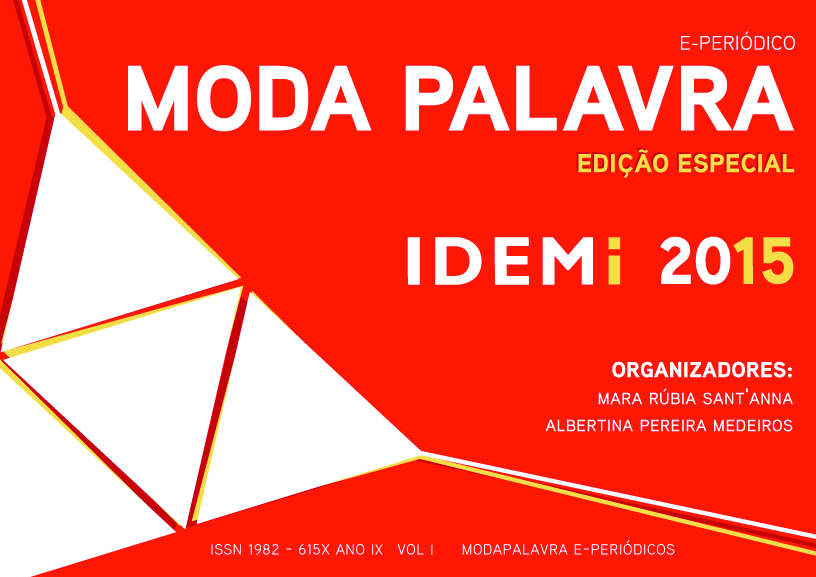Diferenciação e Sustentabilidade a partir do redesign de roupas de roupas de brechó: um modelo de estratégia produtiva
DOI:
https://doi.org/10.5965/1982615x09012015024Palavras-chave:
redesign de roupa de brechó, sustentabilidade, moda e consumoResumo
Pautado em pesquisa bibliográfica e de campo, e em estudo de casos, o presente trabalho apresenta uma reflexão em torno de um modelo de processo produtivo na área do design de moda focado na sustentabilidade. Trata-se de uma proposta metodológica que contempla o redesign de roupas de brechó, descartadas e desvalorizadas por se encontrarem fora das tendências de moda, que poderão passar por um processo de upcycling, estendendo seu ciclo de vida útil e voltando a ter valor estético e de mercado. Objetiva-se mesmo que, numa pequena parcela, contribuir com o meio ambiente de forma criativa e inovadora, tendo como diferencial o fato de possibilitar a reprodução das peças em escala, sem perder a exclusividade.
Downloads
Referências
Livros
LIPOVETSKY, Gilles. O império do efêmero: a moda e seu destino nas sociedades modernas.São Paulo: Companhia das letras, 1989, p.347.
LIPOVETSKY, G.; SERROY, J. A cultura-mundo: resposta a uma sociedade deso- rientada.Tradução: Maria L. Machado. São Paulo: Companhia das Letras, 2011, p. 207.
ERNER, Guillaume. Vítimas da moda? como a criamos, por que a seguimos. São Paulo: Senac, 2005, p.256.
STONE, E. The dynamics of fashion. 3ª. ed. New York: fairchild books, 2008, p.617.
BREZET, JC; ROCHA, C. Towards a model for product-oriented environmental management systems. In J. Charter & U. Tischner (Eds.), Sustainable solutions: developing products and services for the future Sheffield: Greenleaf Publishing, 2001, pp. 243-262.
Artigos
BEZERRA, G.M.F; MATOS, C.K.; PESSOA, J.B.G. “O consumo no futuro”. Anais do 7º. Colóquio de Moda, Paraná, 2011, p.7.
NETO, G.;SOUZA, L.;SCAPINELLO, L. “Reflexões sobre a sustentabilidade no segmento de moda”. Anais do 6° Colóquio de moda, 2010, p.10.
CARNEIRO, R.M.S.; FLORES, A. R.B.; QUEVEDO, S.; ULBRITCHT, V.; VANZIN, T. “O novo consumidor na sociedade do conhecimento”. Anais do 2° Simpósio brasileiro de design sustentável, São Paulo, 2009, p.7.
GIURATTI, L. P.; BERTON, T. J. B.; PINHEIRO, N. “Revival e diferenciação como diretrizes da moda contemporânea: a elaboração de produtos de moda a partir da reciclagem de roupas de brechó”. Anais do 7º. Colóquio de moda, Paraná, 2011 p.7.
ANICET, A.; BESSA, P.; BROEGA, C. “Design de superfícies a partir de resíduos industriais têxteis”. Anais do 3o Simpósio Brasileiro e Internacional de Design Sustentável. Pernambuco, 2011, p.7.
SILVA, J. S. G.;SANTOS.A., 2009. “Implicações dos conceitos da sustentabilidade no design: uma revisão crítica”.Revista tecnologia e sociedade, n. 08,Paraná, p.14.
Sites
Ministério do Desenvolvimento, Indústria e Comércio Exterior. Cadeia Produtiva Têxtil e de Confecções,2012.DistritoFederal.http://www.desenvolvimento.gov.br/sitio/interna/interna.php?area=2&menu=3696>. Acesso em 05 de maio de 2013.
LIVNI, A; SCUDER, F. Manifesto moda lenta. 2010. <http://analivni.com/AnaLivni-MODAlenta-SLOWfashion/filosofia.html>. Acesso em 04 de maio de 2013.
CARTER, Kate.,2008. Why fast fashion is so last season. Disponível em : http://www.theguardian.com/lifeandstyle/2008/jul/23/ethicalfashion.fashion . Acesso on line em 10-09-2014.
MARTINS, S. B.; SAMPAIO, C. P.; MELLO, N. C., 2011. “Moda e sustentabilidade: proposta de sistema produto-serviço para setor de vestuário. projética revista científica de design”. Universidade Estadual de Londrina, v.2, n.1, junho, p.p:126-139. disponível em: <http://www.uel.br/revistas/uel/index.php/projetica/article/view/10532/9259> acesso online em 05 de maio de 2013.
Ecotece.org.. 2012. Retalhos de maiôs viram vestido de festa. <http://ecotece.org.br/blog/tag/upcycle/>. acesso em 6 de maio de 2013.
RABELO,Ricardo, 2012. “A definição dos indicadores de desempenho e os sistemas de produção”.<http://www.das.ufsc.br/~rabelo/ensino/das5313/materialdas5313/modulo1/indicadores_de_desempenho/tipos-sistemas.pdf>.acesso em 20 de abril de 2013.
Downloads
Publicado
Como Citar
Edição
Seção
Licença
Copyright (c) 2016 Nádia Estefânia de de Souza, Lucimar de Fátima Bilmaia Emidio

Este trabalho está licenciado sob uma licença Creative Commons Attribution-NonCommercial 4.0 International License.
Ao submeter um artigo para publicação no ModaPalavra e-periódico, o(s) autor(es) concorda(m) com os seguintes termos:
- Autores mantêm os direitos autorais e concedem à revista o direito de primeira publicação, com o trabalho simultaneamente licenciado sob a Creative Commons Atribuição-NãoComercial 4.0 Internacional, que permite o compartilhamento do trabalho com reconhecimento da autoria e publicação inicial nesta revista, sem pagamento;
- Os autores podem utilizar os mesmos resultados em outra publicações após a primeira publicação, desde que indiquem o ModaPalavra e-periódico como o meio de publicação original;
- Autores têm autorização para assumir contratos adicionais separadamente somente após a publicacão inicial no ModaPalavra e-periódico, desde que indiquem o ModaPalavra e-periódico como o meio de publicação original;
- Autores têm permissão e são estimulados a publicar e distribuir seu trabalho on-line (ex.: em repositórios institucionais ou na sua página pessoal), somente após o processo editorial e primeira publicação, desde que indiquem o ModaPalavra e-periódico como o meio de publicação original;
- Para indicar o ModaPalavra e-periódico como o meio de publicação original, o autor deve seguir texto modelo: "Este artigo foi publicado originalmente pelo ModaPalavra e-periódico, sob a licença CC BY NC, em seu volume [inserir volume], número [inserir número] no ano de [inserir ano], e pode ser acessado em: http://www.revistas.udesc.br/index.php/modapalavra/";
- As opiniões expressas nos artigos são de inteira responsabilidade dos autores, não refletindo necessariamente a opinião da revista. A publicação de artigos, fotos e desenhos foi autorizada previamente pelos responsáveis ou seus representantes para publicação no ModaPalavra e-periódico.









